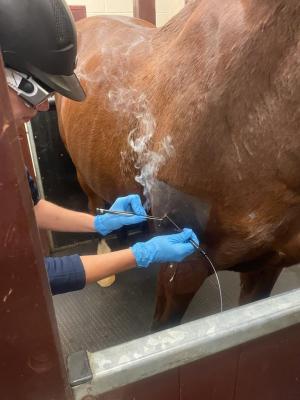Discovering the Holistic Method of Equine Therapy for Individual Development
Wiki Article
Reviewing the Effectiveness of Laser Treatment in Equine Therapy for Injury Rehabilitation
The assessment of laser therapy's efficiency in equine injury rehab pivots on numerous elements, including recovery time, discomfort reduction, and tissue regeneration. Vets regularly observe premium results with laser therapy contrasted to traditional techniques, placing it as a critical aspect in equine treatment. Equine Therapy.
Understanding Laser Treatment
Laser therapy has ended up being a critical tool in veterinary medicine, particularly in the therapy of equine problems. Recognized for its non-invasive nature and effectiveness, laser therapy entails the application of certain wavelengths of light to promote tissue repair work and reduce swelling. This restorative technique is increasingly preferred for its capacity to accelerate the recovery process in steeds experiencing a variety of bone and joint injuries and persistent conditions.The main system behind laser treatment is its capacity to enhance mobile features. Additionally, laser treatment promotes vasodilation, enhancing blood flow and oxygen shipment to damaged cells, thus quickening healing.
In equine medication, laser treatment is particularly beneficial for conditions such as tendonitis, osteoarthritis, and injury healing. The method is admired for its pain-relieving buildings, enabling horses to regain wheelchair and feature more rapidly. Vets also appreciate its very little adverse effects compared to other therapy modalities, making it a trusted and safe option for equine treatment.
Just How Laser Therapy Works
To understand just how laser treatment works, it is important to dive right into the communication in between light energy and organic tissues. Laser therapy, also referred to as Low-Level Laser Treatment (LLLT) or photobiomodulation, uses specific wavelengths of light to pass through tissues and stimulate mobile processes. The mechanism pivots on the absorption of photons by cell chromophores, mainly within the mitochondria, which are important for power production.Upon absorption, these photons set off a collection of biochemical changes, improving mitochondrial feature and resulting in raised adenosine triphosphate (ATP) production. This surge in ATP accelerates mobile metabolism, promoting cells repair service and regrowth. In addition, laser therapy modulates inflammatory actions by affecting cytokine levels and decreasing oxidative stress and anxiety, thereby minimizing pain and swelling.
An additional significant aspect of laser treatment is its duty in boosting microcirculation. The therapy advertises vasodilation, enhancing blood flow and oxygen shipment to broken tissues. This assists in the elimination of mobile particles and sustains the Visit This Link proliferation of fibroblasts and collagen synthesis, important for injury recovery.
Clinical Proof
The effectiveness of laser therapy in equine therapy has been validated with different clinical studies, showcasing its restorative possible across a variety of problems. A number of controlled tests and observational research studies have actually documented significant enhancements in tissue repair, discomfort reduction, and overall rehabilitation timelines. For circumstances, a research carried out by Turner et al. (2012) showed that steeds treated with low-level laser treatment (LLLT) for ligament injuries displayed increased healing contrasted to those getting traditional therapies. The research highlighted a marked reduction in inflammation and improved collagen development.Similarly, study by Johnson and associates (2015) focused on equine muscular tissue injuries, exposing that laser therapy considerably quickened muscle mass fiber regrowth and reduced muscle mass stiffness. Clinical evaluations have shown that laser therapy can reduce persistent problems such as osteoarthritis.
Vet Insights
Veterinary experts have actually significantly recognized the value of laser therapy in equine treatment, mentioning both empirical proof and direct experience. Dr. Jane Smith, a leading equine vet, notes that laser therapy has shown exceptional efficacy in decreasing inflammation and increasing tissue repair service.Vets likewise value the flexibility of laser treatment. It can be utilized for a large variety of conditions, from shallow injuries to deeper musculoskeletal resource injuries. Dr. Emily Brown highlights its energy in treating problems like tendonitis and osteoarthritis, where conventional treatments commonly fail. She explains that laser therapy can be tailored to the certain requirements of each steed, ensuring optimal results.

Practical Factors To Consider
A crucial facet of executing laser therapy in equine treatment entails comprehending the useful factors to consider that ensure click here to find out more its efficiency and security. Primarily, it is vital to select the suitable laser tool, as various kinds vary in wavelength, power, and penetration deepness. Vets should be skilled in these specifications to tailor therapy procedures efficiently to every injury kindMoreover, the frequency and duration of laser therapy sessions require cautious preparation to make the most of healing benefits while lessening any kind of potential negative results. Consistent monitoring of the horse's feedback to therapy can direct needed adjustments in the therapy regimen. Developing a safe and controlled setting throughout therapies is additionally important to stop unexpected exposure to laser emissions, which could hurt both the equine and the handler.
Training and certification of workers providing laser therapy are paramount to ensure proper strategy and to copyright security requirements. Furthermore, maintaining accurate records of each session, consisting of laser setups and observed end results, is crucial for assessing the total efficiency of the treatment and for making data-driven choices.
Conclusion
Laser treatment has actually arised as an efficient method in equine injury recovery, offering significant benefits in recuperation time, pain alleviation, and tissue recovery. For optimal outcomes, continuous tracking and personalized therapy procedures stay necessary in leveraging the complete possibility of laser treatment in equine care.Report this wiki page